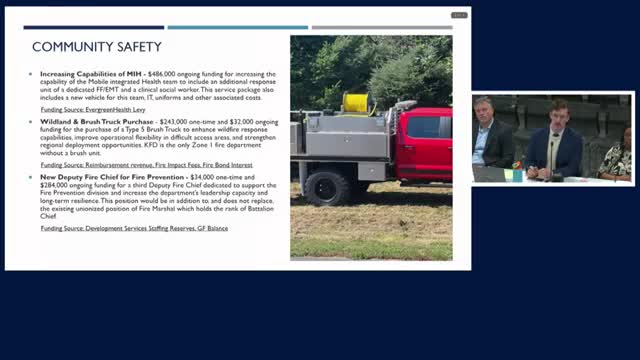Kirkland presents Transportation Safety Action Plan; recommends 20 mph default on local streets, corridor studies for arterial speed limits
November 07, 2025 | Kirkland, King County, Washington
This article was created by AI summarizing key points discussed. AI makes mistakes, so for full details and context, please refer to the video of the full meeting. Please report any errors so we can fix them. Report an error »

Kirkland staff presented a final draft of the Transportation Safety Action Plan (TSAP) on Nov. 5 that lays out crash‑analysis results, near‑miss studies, and a toolbox of engineering, education and enforcement countermeasures to reduce fatal and serious injury crashes. The plan includes a proposed speed‑setting policy that would:
- Set a default 20 mph limit on local streets (policy principle), and
- State a policy preference for a 30 mph maximum on collector and arterial corridors while continuing to use engineering investigations to set arterial limits under state law.
Jennifer Palmer, transportation engineering supervisor, said the plan is built around the "safe systems" approach to reduce deaths and serious injuries, and the city’s Vision Zero goal. "This plan advances Kirkland's vision for a safe, connected, and multimodal transportation system," Palmer said, noting the plan also fulfills grant requirements that require a TSAP adoption.
Crash data and priorities: Staff’s analysis showed a regional pattern: while total crash counts have fallen since 2019 (partly due to COVID‑era traffic reductions), serious‑injury crashes have not declined and vulnerable road users (people walking, rolling and bicycling) account for a disproportionate share of serious and fatal outcomes. The plan identifies top contributing factors in FSI crashes as failures to yield to non‑motorist users, improper turns/merges, excessive speed and impairment.
Policy and implementation: Because state law limits local authority to change arterial speed limits without an engineering study, staff recommended a two‑track method: (1) adopt the 20‑mph local default (which state law allows through local ordinance), and (2) use corridor engineering studies and targeted countermeasures to adjust arterial speed limits (with council review of corridor changes where required). Staff also proposed a phased implementation that blends signage changes, enforcement, education and engineering (redesign where necessary).
Council feedback: Council members praised the breadth of outreach and analysis and stressed that speed limits alone will not change behavior: "We acknowledge that speed limit alone is not going to always change behavior," one councilmember said, and urged pairing limits with engineering and education. Questions included whether de‑minimis arterial changes could be implemented without council action and how corridor‑by‑corridor studies and prioritization would be phased.
Next steps: Staff planned to bring a city ordinance to make the 20 mph local default effective and to return with an implementation/phasing plan for the TSAP and any arterial corridor investigations in early 2026.
Why it matters: The plan focuses municipal investments and maintenance work toward corridors and intersections with highest risk and creates a consistent citywide policy approach that prioritizes safety, particularly for people walking and bicycling.
- Set a default 20 mph limit on local streets (policy principle), and
- State a policy preference for a 30 mph maximum on collector and arterial corridors while continuing to use engineering investigations to set arterial limits under state law.
Jennifer Palmer, transportation engineering supervisor, said the plan is built around the "safe systems" approach to reduce deaths and serious injuries, and the city’s Vision Zero goal. "This plan advances Kirkland's vision for a safe, connected, and multimodal transportation system," Palmer said, noting the plan also fulfills grant requirements that require a TSAP adoption.
Crash data and priorities: Staff’s analysis showed a regional pattern: while total crash counts have fallen since 2019 (partly due to COVID‑era traffic reductions), serious‑injury crashes have not declined and vulnerable road users (people walking, rolling and bicycling) account for a disproportionate share of serious and fatal outcomes. The plan identifies top contributing factors in FSI crashes as failures to yield to non‑motorist users, improper turns/merges, excessive speed and impairment.
Policy and implementation: Because state law limits local authority to change arterial speed limits without an engineering study, staff recommended a two‑track method: (1) adopt the 20‑mph local default (which state law allows through local ordinance), and (2) use corridor engineering studies and targeted countermeasures to adjust arterial speed limits (with council review of corridor changes where required). Staff also proposed a phased implementation that blends signage changes, enforcement, education and engineering (redesign where necessary).
Council feedback: Council members praised the breadth of outreach and analysis and stressed that speed limits alone will not change behavior: "We acknowledge that speed limit alone is not going to always change behavior," one councilmember said, and urged pairing limits with engineering and education. Questions included whether de‑minimis arterial changes could be implemented without council action and how corridor‑by‑corridor studies and prioritization would be phased.
Next steps: Staff planned to bring a city ordinance to make the 20 mph local default effective and to return with an implementation/phasing plan for the TSAP and any arterial corridor investigations in early 2026.
Why it matters: The plan focuses municipal investments and maintenance work toward corridors and intersections with highest risk and creates a consistent citywide policy approach that prioritizes safety, particularly for people walking and bicycling.
View full meeting
This article is based on a recent meeting—watch the full video and explore the complete transcript for deeper insights into the discussion.
View full meeting
